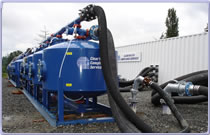

Active Treatment with 1% ChitoVan™ Chitosan Acetate
The west side of Sea-Tac airport was widened by adding 11 million cubic yards of fill dirt to create the 3rd runway. Because the west side of the airport drains to Miller Creek, a protected NW stream, all of the construction stormwater had to be captured and treated prior to discharge.
During the project over 5 billion gallons of water were treated with chitosan without a single mistake. The treated discharge water was monitored continuously for turbidity, pH and volume. In addition, residual chitosan was tested twice per day at each system.
Treatment consisted of adding 1% ChitoVan Chitosan Acetate to flocculate the sediment prior to filtration. From the pretreatment tanks the stormwater (minus about 90% of the original turbidity) was pumped into the multi-pod sand filters for polishing.
The following test results were generated on the Sea-Tac Airport 3rd Runway project using 1% ChitoVan™ with a 4-pod, 54-inch diameter sand filter using a programmable logic controller data monitoring system. 907 data points for influent and effluent pH and turbidity from 2/02/07 through 2/28/07 have been provided in the chart below. The turbidity discharge standard for this project is 5 NTU. The average turbidity reduction during this time period using Chitovan™ was 97.2%. The average turbidity of the water discharged was 1.2 NTU.

Note: The influent turbidity levels appear to be quite low (typically less than 50 NTU) because this water has already been pretreated. The usual untreated turbidity of this stormwater run-off was 500 to 4,000 NTU.
Conclusions: This project, now complete, was the biggest and longest running chitosan treatment project in the 10-year history of chitosan treatment. By any measure the treatment portion of this project performed better than expected. In fact, all of the stormwater treated was discharged at 5 NTU or less.
Back to Applications
